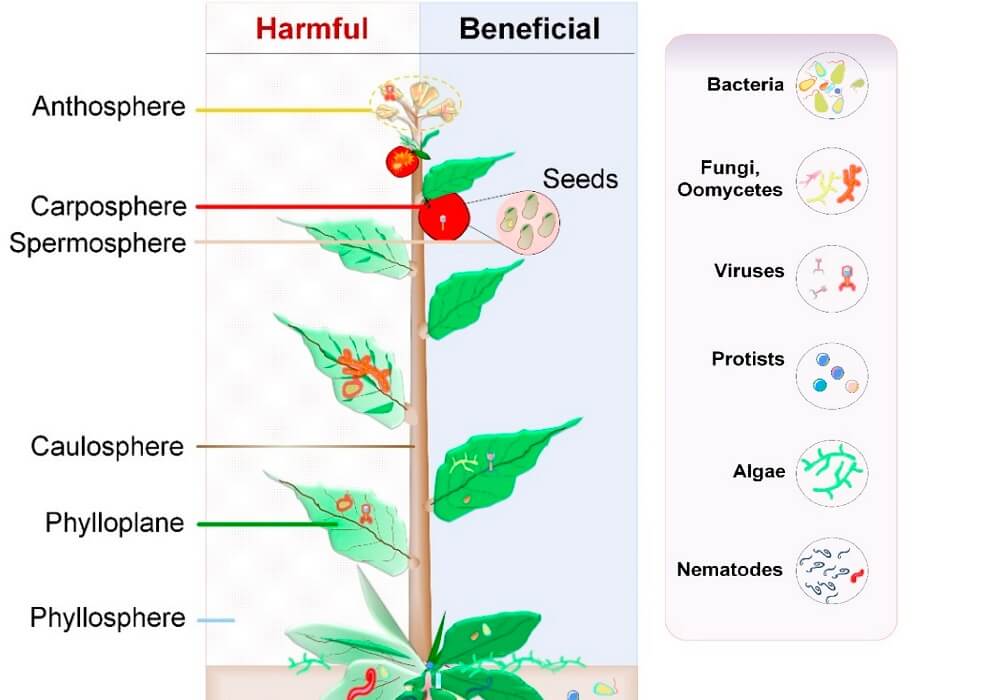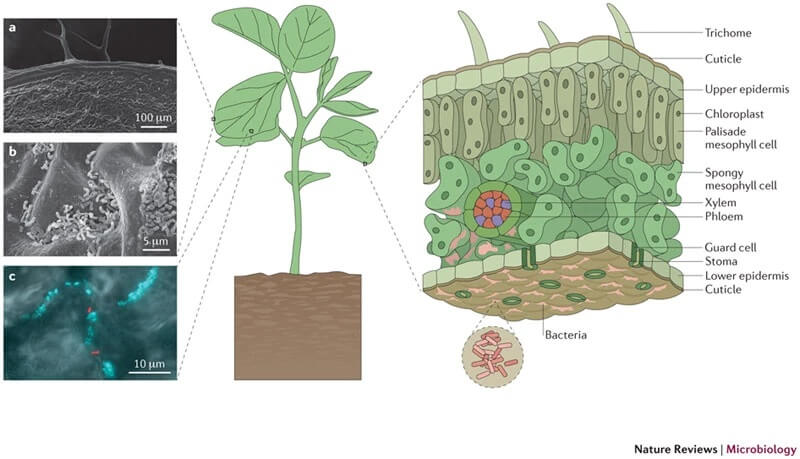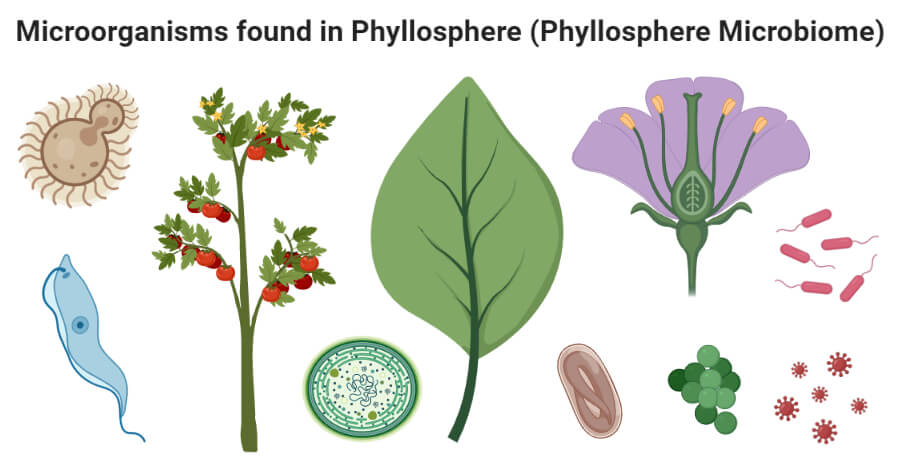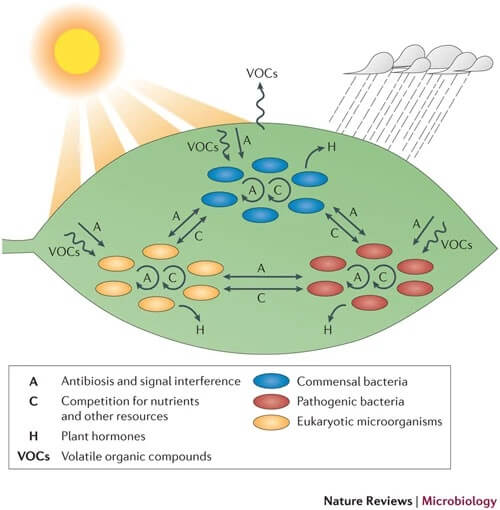Phyllosphere is the aerial part or parts of the plant above the ground like the leaves, stems, and flowers that acts as a habitat for a variety of microorganisms.
- The phyllosphere comprises the aerial parts of plants and is dominated by the leaves followed by stems, flowers, and fruits.
- The phyllosphere is a unique and dynamic habitat constituting irregular, and sometimes relatively large microbial community inhabitants in the ecosystem.
- Although the phyllosphere has been less intensively studied than the rhizosphere, it has received considerable attention in recent years, and interest in the microbiology of aerial surfaces is now acknowledged to extend beyond pathogens.
- The phyllosphere is the ambient region for microbes to colonize and establish its association with plants usually epiphytes.
- Phyllosphere is considered a heterogeneous and dynamic habitat as the parts of the plant are in direct contact with the environment and thus, are affected by even slight changes in the environment.
- While there has been some investigation of the microbial community of buds and flowers, most work on the phyllosphere has focused on leaves, a more dominant aerial plant structure.
- Leaves constitute a huge microbial habitat with larger surface areas and diverse microbial communities.
- The Phyllosphere area has comparatively less microbial number than the rhizosphere as the parts of the phyllosphere is hydrophobic and covered with wax that limits the exudates produced by the parts.
Interesting Science Videos
Microorganisms found in Phyllosphere (Phyllosphere microbiome)

Figure: Microorganisms found in the Phyllosphere (Phyllosphere microbiome). Image Source: MDPI Microorganisms (https://doi.org/10.3390/microorganisms7080269).
- The phyllosphere is an important habitat for diverse groups of microbial communities including bacteria, filamentous fungi, yeasts, algae, and protozoans.
- A variety of bacteria, filamentous fungi, and yeasts naturally colonize the phyllosphere region, followed by less frequent protozoa and nematodes colonization.
- These microorganisms exhibit commensalism or mutualism (symbionts) or antagonism type of relationship on their host plants.
- Among the diverse community of microbes, bacteria are the predominant community on parts like leaves, with its range in between 102and 1012/g of the leaf.
- Generally, the phyllosphere contains four major species of bacteria such as Proteobacteria, Firmicutes, Bacteroides, and Actinobacteria.
- Predominant genera of bacteria found in the phyllosphere include Methylibium, Hyphomicrobium, Methylocella, Proteobacteria, Actinobacteria, Bacteroidetes, Massilia, Flavobacterium, Pseudomonas, and Rathayibacter.
- It has been found that the alpha-, beta- and gammaproteobacteria and firmicutes are the dominant bacterial inhabitants of the phyllosphere.
- Besides, acidobacteria, actinobacteria, and cyanobacteria are the less frequent colonizers of the phyllosphere environment.
- The cultivable yeast genera such as Cryptococcus, Rhodotorula, Sporobolomyces, and their species have mainly inhabited the plant leaf.
- Moreover, the abundance of filamentous fungi has been estimated to range from 102to 108 CFU/g based on the culture-dependent methods.
- Genera such as Alternaria, Penicillium, Cladosporium, Acremonium, Mucor, and Aspergillus are the frequent filamentous fungi colonizing as epiphytes and endophytes.
Read Also: Rhizospheric microorganisms and effects, PGPR and Mycorrhiza
Phyllosphere microbiome of Stem (caulosphere)
- The caulosphere (stems) is a wooden aerial plant part containing large groups of microorganisms.
- The stem is the not most ideal habitat for most microorganisms as the surface of the stem is hydrophobic as a result of the chitin and wax covering.
- However, some groups of microorganisms can still be found in the stem as it is exposed to the air and constantly changing environmental conditions.
- The microbes residing in the caulosphere need adaptation techniques to withstand the change in temperature and moisture content.
- Fungi are the primary resident of the caulosphere, followed by bacteria and nematodes. Fungal species including Saccharomyces, Candida, Hanseniasporaand Lachancea are the common inhabitants.
- Bacteria in the stem are similar to those in the leaves which include bacteria like Pseudomonas, Proteobacteria, and Flavobacterium.
Phyllosphere microbiome of Leaves (phylloplane)

Figure: The phyllosphere comprises the aerial parts of plants and is dominated by the leaves. The middle panel shows a soybean plant, and the right panel shows a magnified schematic cross-section of a leaf. Various microorganisms, and in particular bacteria (shown) and fungi (not shown), can colonize the surface of the leaf and the apoplast. Most of the leaf inhabitants are non-pathogenic bacteria, which are often referred to as commensals. a | Scanning electron micrograph showing the edge of an Arabidopsis thaliana leaf with trichomes visible on the upper side. b | Scanning electron micrograph of epiphytic Sphingomonas sp. Fr 1 on the surface of a leaf. The bacterial cells are located in the grooves formed by the junctions of the epidermal plant cells. c | Epifluorescence image of Pantoea agglomerans str. 299R constitutively expressing cfp, and Pseudomonas syringae pv. tomato str. DC3000 producing mCherry, on an A. thaliana leaf. Parts a,b images courtesy of G. Innerebner, ETH Zurich; part c image courtesy of M. Remus-Emsermann, ETH Zurich. Image Source: Nature Reviews Microbiology.
- The microbial communities of leaves are diverse and consist of many different genera of bacteria, yeasts, filamentous fungi, algae, and, less frequently, protozoa, and nematodes.
- Filamentous fungal communities are considered transient inhabitants of leaf surfaces, with spores as predominant forms, whereas rapidly sporulating species and yeasts colonize the habitat more actively.
- Bacteria are the most abundant inhabitants of the phylloplane, assuming that there are on average 106 –107 bacteria per square cm of the leaf surface.
- The arrangement of leaf epidermal cells determines the leaf physiology and the microenvironment, which allow the abundance and distribution of microorganisms on the leaf surface.
- Epiphytes make biofilm-like growth, preferably in the form of larger bacterial aggregates on the trichomes, veins, and epidermal cell groves, along with the leaf exudates, creating a nutrient-rich region.
- Different physical characteristics of the leaf surface make it a suitable habitat for many microorganisms.
- The presence of the outer cuticle on the leaves and its physiology helps the microbes to colonize the surface, and the leaching of nutrients along with water allows the epiphytes to utilize and develop colonies on the phyllosphere.
- Most bacteria on leaf surfaces do not occur as solitary cells or small groups of cells, as fungi tend to, but form larger aggregates.
- These aggregates are particularly common at the depressions formed at the junctions of epidermal cells, along the veins, and at the bases of trichomes.
- Studies have shown that the bacterial aggregates on leaves consist of 1000 cells or more and that the size of the aggregates positively correlates with water availability.
- Fungal communities in the phyllosphere in temperate regions are hypervariable, and the communities exhibit even greater diversity in the phyllosphere of tropical trees.
- The types of microorganisms inhabiting the phylloplane region also depend on the type of plant species.
Phyllosphere microbiome of Flowers (anthosphere)
- The anthosphere region, that is, the region around the flowers, is also an important dynamic habitat for microbial growth.
- In particular, the anthosphere region around flowers is colonized by a vast diversity of microorganisms, which are flower specific.
- However, some members of the genera Pseudomonas and Acinetobacter (Proteobacteria), Metschnikowia (Ascomycota), and Cryptococcus (Basidiomycota) are consistent members of the floral microbiome across many agricultural and ornamental plants.
- Another notable feature of this interface is the permanence; this habitat has a shorter life span when compared with other spheres.
- Studies on flower associated microbial communities have highlighted that the fungal population is the highest in the anthosphere, followed by bacteria.
- The floral components, namely, pollen, nectar, sepals, petals, stamens, style, ovary, and stigmas, act as short-span microsites for the colonization of microorganisms.
- It has been found that the floral surface organs are abundant with basidiomycetous yeasts, whereas nectar and pollen were filled with ascomycetous yeast species and nectar hosts most fungi compared with other floral parts.
- In pollen, the bacterial count is abundant, ranging between 106 and 109, and the diversity and composition vary from species to species because of the difference in nutrient composition, pollen viability, pollen structure, and moisture.
- The epiphytic bacteria in the atmosphere exist either single or in clusters with the particular formation of thin biofilms in certain habitats.
- Therapeutic metabolites producing endophytic fungi identified as Pestalotiopsis disseminate, Phomopsis, and Coelomycete sp. are also isolated from some medicinal flowers of the temperate region.
Phyllosphere microbiome of Fruits (carposphere)
- Carposphere represents a unique and dynamic habitat, where the microbial communities are subjected to irregular, and sometimes comparatively large changes in temperature, UV radiation, relative humidity, and nutrient availability upon the plant surface.
- Fruits are essential phyllosphere habitat as it is rich in sugar and fruits act as a common source of food for many yeast species.
- Fruit skin inhabits diverse groups of microbes, encompassing both bacteria and fungi.
- The entry of microorganisms inside the fruit is comparatively less frequent due to the presence of a tough, waterproof covering.
- However, the type of microorganisms present on the fruit depends on the chemical composition of the fruit.
- It has been seen that fruits like lemons and orange harbor a large number of yeasts while grapes and apples have a higher number of bacterial cells.
- The microbial community of the carposphere is transient as fruits have a shorter lifespan than other phyllosphere parts.
- Microbial communities in the fruits might differ throughout their development as the microorganisms present in the buds of fruits might not be present in the developed fruit.

Factors influencing their growth and activities
Different environmental and plant factors influence the microbial communities in the phyllosphere region.
A. Light
- The microorganisms in the phyllosphere region, unlike that in the rhizosphere, are influenced by the light.
- Bacteria and fungi utilize sunlight to produce different chemical products that promote their growth and plant growth.
- Light also affects several aspects of plant physiology which influences plant secretions, affecting microbial growth.
- UV radiation affects the production of plant secondary metabolites, diversity of the microbial population, and the behavior towards biological control agents.
B. Temperature
- Abiotic factors like temperature affect the growth of activities of phyllosphere microorganisms and the phyllosphere-plant interactions.
- Temperature fluctuations are observed with the changes in day and night regimes in the phyllosphere region.
- Temperature affects both the plants, microorganisms, and their interactions which affects the rates of physical, chemical, and biological processes in the region.
- Microbial colonizers of the phyllosphere region are subjected to diurnal and seasonal fluctuations of heat and moisture.
C. Plant species
- The identity of the host plant has a significant influence on the identity of its microbiome.
- Different plant species growing adjacent to one another can harbor distinct microbiomes.
- Factors like the nutrient content of the fruits, flowers, and stems affect the growth and activities of the microbiome present on the plants.
- Plant age and developmental stage determine the interactions between plant and microorganisms, which might change with the changes in the plant development.
- The immune system of the plant plays a vital role in determining microbial assembly.
D. Microbe-microbe interactions
- The extent to which microbe-microbe interactions can play roles in the microbiome composition is not well understood.
- But the outcome of microbe-microbe interactions could be explained as cooperation, parasitism, and competition.
- Each group of microorganisms plays a unique and vital role in microbiomes, and their absence could cause a significant alteration in microbiome composition and functioning.
- There can be direct microbe-microbe interactions, such as the hyper-parasitism (parasite of a parasite) of primary colonizers and opportunists that utilize the host’s compromised plant defenses to colonize them and cause diseases.

Figure: A summary of some of the complex types of interactions that are expected to occur among commensal and pathogenic microorganisms and between the microorganisms and the plant. Microorganisms compete with each other for space and nutrient resources, both within each population and between the populations. Antibiosis, cell signaling, and signaling interference systems act among the different groups and also between the plant and the microorganisms, and microorganisms might produce plant hormones that affect the plants. In addition to these factors that determine microbial interactions and plant–microorganism interactions, the environmental conditions, including radiation, rain, and wind, directly and indirectly, affect the biotic interactions. Image Source: Nature Reviews Microbiology.
Positive effect of Phyllosphere microorganisms on Plants
- Phyllosphere microorganisms often have a direct positive influence on plants by altering plant surface properties, enhancing nitrogen fixation, and promoting the growth of plants, the control of plant pathogens, and the degradation of organic pollutants.
- Phyllosphere microflora significantly influences the ecological relationship, adaptation, growth, resistance, and infection of the plant host.
- The phyllosphere microbiome affects leaf functions and longevity, seed mass, apical growth, flowering, and fruit development.
- Beneficial microbes play an important role in increasing yields of the crop, removing contaminants, and producing novel substances.
- Phyllopsphere microbial communities produce plant growth factors like IAA and cytokines that promote nutrient uptake and crop yield.
Negative effect of Phyllosphere microorganisms on Plants
- The presence of a large number of microorganisms in the phyllosphere might increase competition with plants for nutrients, water, and space.
- Microbe-microbe interactions in the phyllosphere region result in the loss of different beneficial microorganisms.
- Some of the members of the phyllosphere microbiome might act as plant pathogens, resulting in different forms of plant diseases.
References
- Arunkumar, N., Rakesh, S., Rajaram, K., Kumar, N. R., & Durairajan, S. S. K. (2019). Anthosphere Microbiome and Their Associated Interactions at the Aromatic Interface. Plant Microbe Interface, 309–324.doi:10.1007/978-3-030-19831-2_14
- Sivakumar N, Sathishkumar R, Selvakumar G, Shyamkumar R, Arjunekumar K. Phyllospheric Microbiomes: Diversity, Ecological Significance, and Biotechnological Applications. Plant Microbiomes for Sustainable Agriculture. 2020;25:113-172. Published 2020 Mar 7. doi:10.1007/978-3-030-38453-1_5
- Lindow SE, Brandl MT. Microbiology of the phyllosphere. Appl Environ Microbiol. 2003;69(4):1875-1883. doi:10.1128/aem.69.4.1875-1883.2003
- Bringel Françoise, Couée Ivan. Pivotal roles of phyllosphere microorganisms at the interface between plant functioning and atmospheric trace gas dynamics. Frontiers in Microbiology. 6. 2015. https://www.frontiersin.org/article/10.3389/fmicb.2015.00486. DOI: 10.3389/fmicb.2015.00486
- Pascazio, S., Crecchio, C., Ricciuti, P., Palese, A. M., Xiloyannis, C., & Sofo, A. (2015). Phyllosphere and carposphere bacterial communities in olive plants subjected to different cultural practices. International Journal of Plant Biology, 6(1).doi:10.4081/pb.2015.6011
- Koricha et al (2019). Occurrence and Molecular Identification of Wild Yeasts from Jimma Zone, South West Ethiopia. Microorganisms2019, 7(12), 633; https://doi.org/10.3390/microorganisms7120633
- Carvalho et al. 2018. Influence of Light on Plant–Phyllosphere Interaction. Plant Sci., 12 October 2018 | https://doi.org/10.3389/fpls.2018.01482
- Khondoker M.G. Dastogeer, Farzana Haque Tumpa, Afruja Sultana, Mst Arjina Akter, Anindita Chakraborty. Plant microbiome–an account of the factors that shape community composition and diversity. Current Plant Biology. Volume 23 2020. https://doi.org/10.1016/j.cpb.2020.100161.

The information is useful and interesting.